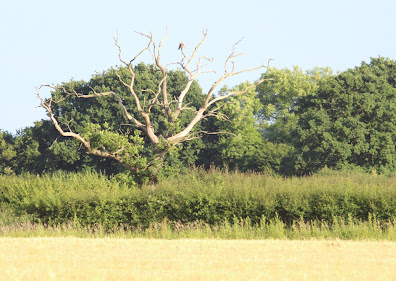Adam Firth found yet another good bird out of his window late afternoon yesterday, a Black Kite (following Pallid Swift in November!). He suspected a bird that had joined the local Red Kites and Buzzards feeding over a cut hay field was this species and managed to get a couple of photos, which looked very good for Black Kite. Having just got home from work, I shot over to Elvington, meeting Duncan by the side of the road. To our delight I picked up a kite almost immediately; it was head on, but looked compact and when it turned, we both exclaimed 'it's a Black Kite!' simultaneously. The bird circled over the fields and then appeared to drop down.
Meeting up with Adam and then Ollie we headed over to where I thought it had dropped and after a few tense minutes, Ollie picked it up feeding in the stubble.
After a while, it was flushed by a Red Kite and it flew up and proceeded to spar with the Red, giving wonderful views. It then landed in a dead Oak, giving incredible views in the evening sunshine. Big smiles and high fives all round, and congratulations to Adam for finding this super bird.
Black Kite carrying food, seemingly a young Pheasant killed by the grass-cutting.
The Kite had a yellow eye and cere and seemed to be in wing moult, so I wondered if this was a different bird to the one I saw in Helmsley back in April, as it seemed to be an older bird. If accepted, this will be the third record for the York area following one at Bubwith in 1979 and then the surprise pair of juveniles at Wheldrake Ings, on 2nd August, 2020. However, it is the first to be twitchable. We left the bird in peace and it seemed to drop back into the field to feed. Apparently, it roosted in a tree late evening so will no doubt be seen again tomorrow.
Handy comparisons of Black and Red Kites. Note the Black Kite's more compact shape, shorter tail and broader wing-tips with a sixth visible primary finger. The plumage is generally dull brown, with paler head and a prominent upperwing covert bar, which unlike on the Red Kite doesn't meet across the back. The tail is also less forked than the Red Kite.
L-R: Ollie Metcalfe, Jono Leadley, Adam Firth and Duncan Bye - Very happy York birders!








No comments:
Post a Comment